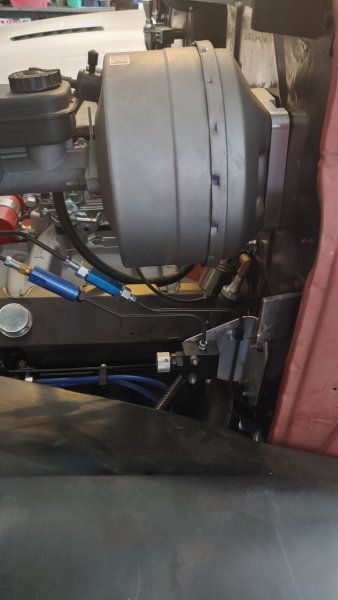In the other thread you talk about your 4 disc system and say you installed 2-lb residual valves.
I have front disc, rear drum and it got me to thinking. I found this info on the Summit Racing website talking about residual valves. I have 2 questions -
1. I need to confirm if my Raybestos Blue Master Cylinder has a 10-lb residual valve in line with the drum side port and no residual valve in line on the disc side port.
2. I'm wondering if I add a 2-lb residual valve at the front disc side if it could allow more pressure build up at the front 4-piston Wilwood calipers and get rid of the sponginess? But, below it says :
When converting from drum to disc brakes, remove the 10-psi valve. The constant line pressure causes the brakes to drag.
It also says:
In some vehicles, the master cylinder is relocated to a lower position. This could be under the floor or on the frame rail. In this design, a residual valve is required to prevent fluid back-flow. Without a residual valve, the pedal could feel “spongy.” It would also take more pedal travel to move enough fluid to engage the brakes.
My MC is firewall mounted above the calipers. Could an added 2-psi residual valve provide any benefit? I need sooner pad engagement with no spongy feel a bit after the start of pedal travel. Right now its engaging 2/3 of the way down and feels spongy.
https://help.summitracing.com/app/answers/detail/a_id/5297/~/what-is-a-residual-valve%3F
In OEM applications, the residual pressure valve is usually built-in to the master cylinder. In this case, an external valve is not required.
A 10-psi Residual Valve is used with drum brakes. The valve holds 10 psi in the brake lines going to the wheel cylinders. This keeps pressure against the return springs inside the drum. This means the brakes engage faster with less pedal travel.
Most disc brake systems do not require a residual valve. However, a 2-psi Residual Valve is used when the master cylinder is lower than the calipers.
When the master cylinder is mounted on the firewall, it is usually higher than the calipers. Gravity keeps the fluid from flowing backwards. In this case, a residual valve is not required.
In some vehicles, the master cylinder is relocated to a lower position. This could be under the floor or on the frame rail. In this design, a residual valve is required to prevent fluid back-flow. Without a residual valve, the pedal could feel “spongy.” It would also take more pedal travel to move enough fluid to engage the brakes.
Notes
- When converting from drum to disc brakes, remove the 10-psi valve.
- The constant line pressure causes the brakes to drag.
- This will cause overheating and premature wear.
My front calipers and rotors are
from a 1980's Ford Granada. Not
new. (got them for free). They hooked
up to the Mustang II R&P easily.
The spindles are 70's Pinto.
(super strong).
The 2lb check valves do not cause
the pads to excessively drag on the
rotors, but in some cases will give
the brake pedal a firmer feel. After
initially installing my brake system
(it's more or less custom and pieced
together), I did not have the check
valves installed. Tight footwell in
the cab required modification of the
pedal arm to move it closer to the
gas pedal, and lower it. This changed
the pedal ratio. After the mods the
pedal had a spongy feel, so I
installed the check valves. Pedal
is now firm, and the brakes work well.





















